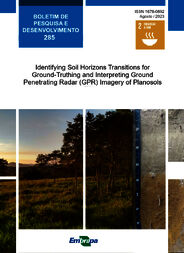Identifying soil horizons transitions for ground-truthing and interpreting ground penetrating radar (GPR) imagery of Planosols.
Identifying soil horizons transitions for ground-truthing and interpreting ground penetrating radar (GPR) imagery of Planosols.
Author(s): NASCIMENTO, C. W. R. do; CEDDIA, M. B.; VASQUES, G. M.; RODRIGUES, H. M.; MARTINS, S. S.; OLIVEIRA, R. P. de; TAVARES, S. R. de L.
Summary: The Ground Penetrating Radar (GPR) has potential to characterize soils both vertically and horizontally. The effectiveness of using GPR relies on the interpretation of soil targets in the radargrams. For identifying the targets in their correct depths, a velocity model of the terrain is required. However, a velocity model cannot be directly obtained from GPR models using a monostatic antenna. An alternative is the generation of a depth model by measuring the velocity of the electromagnetic pulse from hyperbolas created in the radargram from the interaction of the pulse with point scatterers. On the other hand, the radargram does not always present these point scatterers for the estimation of the pulse velocity and generation of an accurate depth model. Thus, this work aimed to assess the feasibility of using iron rods as markers of the depths of soil horizons transitions in GPR images (750 MHz antenna) of Planosols, and as point scatterers to generate hyperbolas for deriving depth models for converting the Y-axis of the radargram from time to depth units. The experimental area is located in Seropédica municipality, southeastern Brazil. Three soil profiles were described and classified as Planosols, which were located at the footslope position. Iron rods (80-cm long by 8-mm in diameter) were inserted horizontally in the transitions of the soil horizons. Images (radargrams) were obtained using a GPR with a monostatic shielded antenna of 750 MHz frequency. The radargrams were pre-processed using static correction and dewow to remove noise. The pulse velocity was estimated by fitting the hyperbolas generated by the buried iron rods. As results, the 750 MHz antenna allowed visualizing the iron rods features (hyperbolas), especially in sandier horizons in the radargrams. Pulse velocity estimation was possible, which allowed the time-to-depth conversion of the Y-axis, and thus, positioning vertically the horizons transitions in the radargrams. In Planosols, the vertical and horizontal distribution of the E-to-B horizon transitions, as imaged by the GPR, is important information for irrigation planning, land zoning and soil survey.
Publication year: 2023
Types of publication: Booklets
Unit: Embrapa Soils
Observation
Some of Embrapa's publications are published as ePub files. To read them, use or download one of the following free software options to your computer or mobile device. Android: Google Play Books; IOS: iBooks; Windows and Linux: Calibre.
Access other publications
Access the Agricultural Research Database (BDPA) to consult Embrapa's full library collection and records.
Visit Embrapa Bookstore to purchase books and other publications sold by Embrapa.

